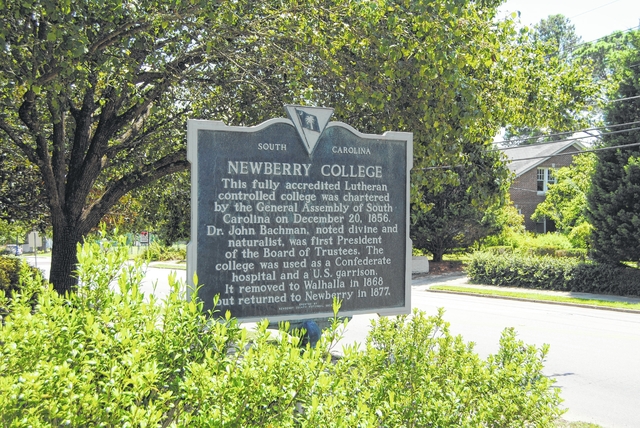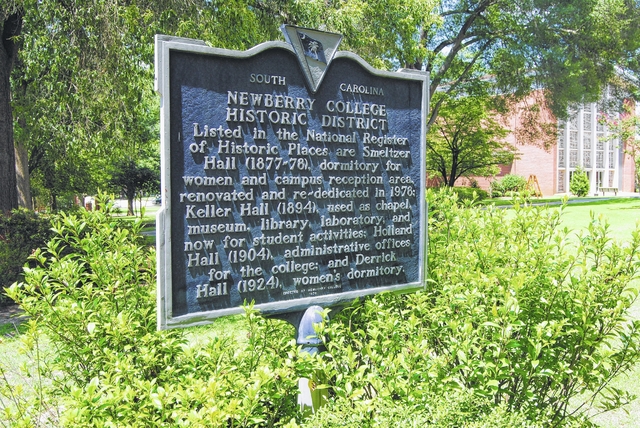NEWBERRY — Newberry College’s beginning dates to 1828 when the president of the Evangelical Lutheran Synod of South Carolina made it known there was a need in the state to train clergy.
In the years to come, what became Newberry College would serve as a military hospital for Confederate troops during the Civil War, be looted and literally destroyed by occupying Federal troops, and be forced to move to Walhalla in 1868 after the campus was left in ruins.
The history of the college is noted by two historical markers on the current campus in Newberry and by one in Walhalla, site of the college from 1868 to 1877. Newberry College has had 22 sitting presidents and two acting presidents.
The history
Gordon Henry writes about the early years of Newberry College in his book, “God Bless Newberry College!” and the influence of the Rev. John Bachman, the president of the Evangelical Lutheran Synod of South Carolina who had said a seminary was needed.
“The Synod accepted Bachman’s challenge to establish a seminary,” Henry wrote, and opened a seminary in the home of Col. John Eigelberger of Pomaria, about 15 miles from the current day campus. It stayed there for one year before moving in Lexington after the death of its first principal, the Rev. John Schwartz.
“In 1854 the Synod voted to move the school to a new location and in 1855 selected Newberry as the site for the relocated seminary and for a new degree grading institution,” Henry writes.
Newberry College was charted on Dec. 20, 1856, by the General Assembly of South Carolina. Bachman was elected chairman of the first board of trustees on Jan. 15, 1857.
Dr. Tracy Power, assistant professor of history and director of College Archives, said three of the presidents helped ensure the college’s survival into the 21st century: Josiah P. Smeltzer, George Holland and George Cromer, all of whom served between 1861 and 1904, and each of whom has a building named for him on campus.
Smeltzer had what was perhaps one of the toughest terms because the Civil War began during the beginning of his tenure as president.
According to “God Bless Newberry College!” Smeltzer wrote in his journal in March 1865: “The Northern troops came within 14 miles of Newberry. I was alarmed; I heard so many rumors and do not know what to do. I buried the records of the college in my possession. But the army did not reach here and were were preserved.”
Confederate authorities made the Newberry campus a military hospital in March 1865.
“After the surrender, Federal troops under the command of Brevet Brigadier General Charles Van Wyck of the 56th Infantry Regiment of New York Volunteers occupied the building from July 9 to October 1, 1865 to form a garrison of the town and regulate civil affairs,” Henry writes.
Smeltzer wrote in his journal how great damage was done to the campus during the occupation of the campus. He wrote that the fencing was carried off, the blinds of the windows, the doors, the benches, desks, etc., were destroyed, sold, or used as firewood by the troops. He said that the library was forcibly opened and many volumes were carried off.
“The College received a Congressional appropriation of $15,000 in 1898 for damage done by the occupying troops,” Henry writes.
From 1868 to 1877, the last years of Smeltzer’s presidency, the college moved to Walhalla because the building was in ruins. The board of trustees voted to sell the property and look for a new location, according to “God Bless Newberry College!”
Smeltzer and the students enrolled at Newberry during 1867-1868 — 10 total — took the College Bell, what remained of the library and a few benches and blackboards with them to Walhalla but that move brought financial problems with it.
According to records, enrollment was never large enough to generate needed financial support so it was decided that the college would move back to Newberry in 1877, and Smeltzer handed in his resignation. He wrote in his journal that he thought it was a mistake for the college to return to Newberry. The College has been located here since.
Other noted moments in Newberry College history, according to “God Bless Newberry College!”:
• Newberry College admitted women as day students in 1897.
• In 1930 Newberry College merges with Summerland College, making the college fully coeducational.
• In 1966 the college admits the first African-American student, Nancy Lou Anderson, a day student.
Some notable alumni include Mark Hammond, current South Carolina secretary of state; Coleman Livingston Blease, 90th governor of South Carolina; Lee Atwater, political strategist; and numerous pro football players like Ron Parker, Brandon Bostick and Corey Washington.
The markers
Newberry College has three historic markers — two located on the Newberry campus and one in Walhalla.
The first marker, erected in 1970 by the Newberry County Historical Society and located at the entrance to campus, reads: “This fully accredited Lutheran controlled college was chartered by the General Assembly of South Carolina on December 20, 1856. Dr. John Bachman, noted divine and naturalist, was the first President of the Board of Trustees. The college was used as a Confederate hospital and a U. S. garrison. It removed to Walhalla in 1868 but returned to Newberry in 1877.”
The second marker, erected in 1978 by Newberry College and located on College Street in front of Smeltzer Hall, reads: “Listed in the National Register of Historic Places are Smeltzer Hall (1877-78), dormitory for women and campus reception area, renovated and re-dedicated in 1978; Keller Hall (1894), used as chapel, museum, library, laboratory, and now for student activities; Holland Hall (1904), administrative offices for the college; and Derrick Hall (1924), women’s dormitory.”
The front of the third marker, located at 101 E. North Broad St. in Walhalla, reads: “Newberry College, founded in 1856, moved here from Newberry in 1868 and remained in Walhalla until 1877, returning to Newberry for the opening of the 1877-78 academic year. The Lutheran college struggled during the Civil War and its aftermath as enrollment dropped and debts mounted. in 1869 it sold its main building and other property in Newberry at auction to pay its significant debts.”
The back reads: “Walhalla, with a large community of Germans who were primarily Lutherans, was chosen as a suitable home for the college, which retained the name Newberry. Under Josiah P. Smeltzer (1818-1887), president 1861-77, the college first occupied a building at Main and College Streets and then one at College and North Broad Streets. In 1877 the Synod of S.C. and Adjacent States voted to move it back to Newberry.”
It was erected by the Oconee County Arts and Historical Commission in 2006.


